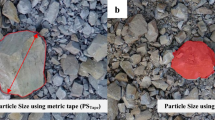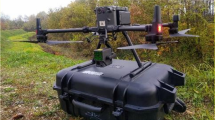Abstract
The main topic of this research was to propose an optimizing modeling method of landslide topography. This method fuses high-resolution imagery from an unmanned aerial vehicle (UAV) with laser point cloud. Due to the relatively high efficiency and large coverage area, the UAV system is suitable for emergency investigation of landslide. Based on the UAV images and laser point cloud, the use of partial differential equation (PDE) combines the hole repair technology with non-uniform rational B-splines (NURBS) method to rapidly reconstruct a three-dimensional (3D) scene. The mean square error (MSE) determined by comparison with measured data from the laser scanner technology is 16.1274 mm. And the error of plane calculated by the NURBS surface fitting is smallest by comparing with the least-squares plane fitting, Delaunay triangulation and polygon mesh method. In addition, the realistic 3D landslide model is obtained by texture mapping. The XiaPa landslide in Liangshan District, Xichang City, Sichuan Province China, was selected as a case study, in which the accuracy is evaluated to prove that the model has higher precision than traditional methods. The experiment results show that the integrated approach in this paper could be implemented in qualitative and quantitative risk assessment procedures pertaining to landslides.










Similar content being viewed by others
References
Al-Rawabdeh A, He F, Moussa A, El-Sheimy N, Habib A (2016) Using an unmanned aerial vehicle-based digital imaging system to derive a 3D point cloud for landslide scarp recognition. Remote Sens 8(952):95
Chau KT, Sze YL, Fung MK, Wong WY, Fong EL, Chan L (2004) Landslide hazard analysis for Hong Kong using landslide inventory and GIS. Comput Geosci 30(4):429–443
Duan G, Niu R, Peng L, Fu J (2017) A landslide displacement prediction research based on optimization-parameter ARIMA Model Under the inducing factors. Geomat Inf Sci Wuhan Univ 42(4):531–536
Guzzetti F, Cardinali M, Reichenbach P, Carrara A (2000) Comparing landslide maps: a case study in the Upper Tiber River basin, central Italy. Environ Manag 25(3):247–263
Harwin S, Lucieer A (2012) Assessing the accuracy of georeferenced point clouds produced via multi-view stereopsis from unmanned aerial vehicle (UAV) imagery. Remote Sens 4(6):1573–1599
Hovius N, Stark CP, Allen PA (1997) Sediment flux from a mountain belt derived by landslide mapping. Geology 25(3):231–234
Huang Y, Yu M, Xu Q, Sawada K, Moriguchi S, Yashima A, Liu C, Xue L (2015) InSAR-derived digital elevation models for terrain change analysis of earthquake-triggered flow-like landslides based on ALOS/PALSAR imagery. Environ Earth Sci 73(11):7661–7668
Jaboyedoff M, Oppikofer T, Abellan A, Derron M, Loye A, Metzger R, Pedrazzini A (2012) Use of LIDAR in landslide investigations: a review. Nat Hazards 61(1):5–28
Jakob M (2000) The impacts of logging on landslide activity at Clayoquot sound, British Columbia. CATENA 38(4):279–300
Kraus K, Pfeifer N (1998) Determination of terrain models in wooded areas with airborne laser scanner data. ISPRS J Photogramm Remote Sens 53(4):193–203
Lazzari M, Gioia D (2017) UAV images and historical aerial-photos for geomorphological analysis and hillslope evolution of the Uggiano medieval archaeological site (Basilicata, southern Italy). Geomat Nat Hazards Risk 8(1):104–119
Li Z, Lezuo P, Pattappa G, Collin E, Alini M, Grad S, Peroglio M (2016) Development of an ex vivo cavity model to study repair strategies in loaded intervertebral discs. Eur Spine J 25(9):2898–2908
Lin K, Wu D, Liu S, Li P (2015) 3D face recognition algorithm based on partial differential equations deformable model. Appl Res Comput 32:2827–2830
Liu J, Tang H, Zhang J, Shi T (2014) Glass landslide: the 3D visualization makes study of landslide transparent and virtualized. Environ Earth Sci 72(10SI):3847–3856
Marcato G, Mantovani M, Pasuto A, Zabuski L, Borgatti L (2012) Monitoring, numerical modelling and hazard mitigation of the Moscardo landslide (Eastern Italian Alps). Eng Geol 128(SI):95–107
McKean J, Roering J (2004) Objective landslide detection and surface morphology mapping using high-resolution airborne laser altimetry. Geomorphology 57(3–4):331–351
Na L, Yang J, Guo A, Liu Y, Hai L (2016) Triangulation reconstruction for 3D surface based on information model. Cybern Inf Technol 16(5):27–33
Pirasteh S, Li J (2018) Developing an algorithm for automated geometric analysis and classification of landslides incorporating LiDAR-derived DEM. Environ Earth Sci 77(11):414
Ram M, Gupta A (2016) Numerical solution to stochastic partial differential equation with variable repair rate. Commun Stat Theory Methods 45(21):6245–6252
Rowlands KA, Jones LD, Whitworth M (2003) Landslide laser scanning: a new look at an old problem. Q J Eng Geol Hydrogeol 36(2):155–157
Siebert S, Teizer J (2014) Mobile 3D mapping for surveying earthwork projects using an unmanned aerial vehicle (UAV) system. Autom Constr 41:1–14
Travelletti J, Delacourt C, Allemand P, Malet JP, Schmittbuhl J, Toussaint R, Bastard M (2012) Correlation of multi-temporal ground-based optical images for landslide monitoring: application, potential and limitations. ISPRS J Photogramm Remote Sens 70:39–55
Wang C, Shi Z, Niu X (2010) An error driven 3D face modeling scheme based on partial differential equations. In: Sixth international conference on intelligent information hiding and multimedia signal processing (IIH-MSP 2010), Darmstadt, Germany, 15–17 October 2010, Proceedings. IEEE Computer Society
Xie M, Esaki T, Zhou G (2004) GIS-based probabilistic mapping of landslide hazard using a three-dimensional deterministic model. Nat Hazards 33(2):265–282
Yu M, Huang Y, Zhou J, Mao L (2017) Modeling of landslide topography based on micro-unmanned aerial vehicle photography and structure-from-motion. Environ Earth Sci 76(15):520
Acknowledgements
This work was supported in part by the National Key R&D Program of China (Grant no. 2016YFC0401908). The author would like to thank the anonymous reviewers for their constructive comments.
Author information
Authors and Affiliations
Corresponding author
Additional information
Publisher's Note
Springer Nature remains neutral with regard to jurisdictional claims in published maps and institutional affiliations.
Rights and permissions
About this article
Cite this article
Ji, H., Luo, X. 3D scene reconstruction of landslide topography based on data fusion between laser point cloud and UAV image. Environ Earth Sci 78, 534 (2019). https://doi.org/10.1007/s12665-019-8516-5
Received:
Accepted:
Published:
DOI: https://doi.org/10.1007/s12665-019-8516-5




